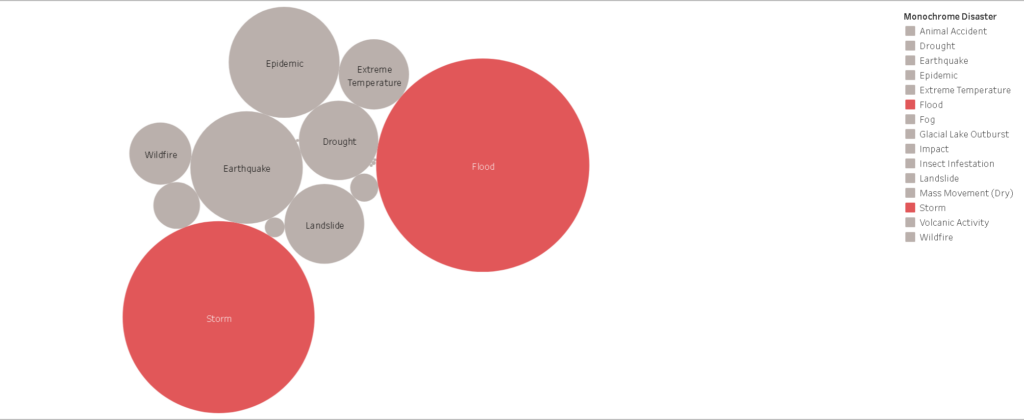I was just six years old then, naive to the world’s complexities and the forces of nature. When the skies over Mumbai opened up like never before, unleashing a flood that would go down in history as one of the most devastating natural disasters the city has ever faced. As a child, the endless rain, the sounds of chaos, and sight of a whole city underwater are etched into my memory, a reminder of natures unforgiving power.
Yet, this experience pales in comparison to the cumulative impact of natural disasters over the last century. From earthquakes that have reshaped cities to hurricanes that have rewritten the fate of entire regions, these events have not only caused immeasurable loss but have also ignited a global conversation on climate change, disaster preparedness, and resilience.
In this case study I dove deep into the multifaceted world of natural disasters recorded all the way from back in 1900 up to the year 2021. I successfully explored the evolution of disaster frequency, Severity, and types while investigating their human, economic and consequences. Furthermore, I also assess the effectiveness of governmental and aid organizations’ responses to these calamities, uncovering potential areas for enhancing disaster preparedness and resilience. This analysis not only reflects on the past century’s challenges but also contributes to the ongoing global dialogue on climate change and disaster management strategies.
Historical Overview
It’s impossible not to feel a mixture of awe and heartbreak while working with this dataset. The last century alone has witnessed events of such magnitude that they’ve permanently altered the course of human history. The 2004 Indian Ocean tsunami, for instance, claimed over 230,000 lives across 14 countries, underscoring the indiscriminate power of nature. The 1989 Loma Prieta earthquake shook Northern California, leaving a tangible mark on both the landscape and the community’s collective memory.

The sheer volume of data available today, compared to even a few decades ago, allows us to analyze trends with greater accuracy and detail. This wealth of information not only helps in identifying patterns but also in preparing more effectively for future events. The plot above reveals that, over the past 100 years, natural disasters have not only increased in frequency but have also grown in complexity, with climate change playing a significant role in exacerbating their impact. However, improved reporting mechanisms and a growing global population also play significant roles.
Human and Economic factors
Dissecting the types of disasters, it’s fascinating yet somber to note the disparity between their commonality and severity. Floods and storms, frequent and furious, have swept through communities, leaving behind stories of survival and resilience. Floods especially have claimed over 6 million lives. Yet, it’s the droughts and epidemics, less frequent but far more deadly, that have claimed over 20 million lives. This dichotomy underscores the importance of not just counting events but understanding their impact on human life.

Geographically, Asia (especially Southern, South-Eastern, and Eastern Asia have recorded more than 3000 disasters), the Americas (both South and North), and Africa (Eastern and Western regions) are notably prone to natural disasters. This underscores the need for targeted disaster preparedness and response initiatives in these areas.
Certain disasters have left indelible marks on history due to their magnitude. The 1931 China floods, the 1917 epidemic in the Soviet Union, and the 2011 earthquake in Japan are stark reminders of nature’s formidable power. Furthermore. reflecting on the economic ramifications, the 2011 earthquake in Japan, with damages nearing $210 billion, and the 2005 storm in the United States, with costs around $125 billion, illustrate the profound economic impacts of these events. Japan’s 1995 earthquake, causing roughly $100 billion in damages, underscores the nation’s seismic vulnerabilities. Improving disaster preparedness and response is a multifaceted challenge. It requires a holistic approach, from enhancing early warning systems to fostering community engagement.
Conclusion
Exploring the global impact of natural disasters over the last century has been both a humbling and enlightening journey. It serves as a reminder of our collective vulnerability and the strength we possess to confront these challenges. I encourage every reader to consider how they can contribute to a more resilient future, whether through local preparedness efforts or global climate action advocacy. Together, we can counter nature’s forces, not with defiance, but with understanding, preparation, and resilience.
Check out my Github for more visualizations: https://github.com/TirtheshJani/Case_Study_Natural_Disasters_1900_2021